
Saturday June 14th was supposed to be the day of the event discussing election fraud in Kootenai County. On June 11th, Watchmen Ministry North Idaho cancelled the event. Why would we cancel the event at such a late date? The real answer comes down to three very important points:
- When we reviewed the data that Eye on Elections was using to support its claim of election fraud, we were unable to verify it. In addition, the data that we did uncover rebuts the assumption that underlies the fraud claims Eye on Elections was making. We did not see the slides from Eye on Elections until Monday the 9th of June. We spent Tuesday the 10th analyzing and reviewing their claims.
- Eye on Elections was advertising the event as if both Watchmen Ministry North Idaho and Eye on Elections were making claims of voter fraud. This was not our intention. Our intention was that we would host the event and Eye on Elections would be the speaker at the event. We have done this for other events that we have hosted in the past. None had caused the amount of confusion that this announcement did.
- Once we realized that the data did not support the claims that Eye on Elections was making, we consulted with others as to how to best protect ourselves given the lawsuit against Mike Lindell by Dominion Voting Systems. What was abundantly clear in the lawsuit was that Mike Lindell was unable to prove his claims, the data and the paper ballots disproved them and that he knew his claims were unprovable.
Given those three very important pieces of information, that is why we cancelled the event. Eye on Elections has presented this as we were afraid of getting sued for slander, but neglects to mention that our concern was that the claims could not be substantiated and therefore the main reason for canceling. It would be unwise for us to have the appearance of supporting Eye on Election’s claims even if we clearly stated that we disagreed with them. It would also be unfair for the people of Kootenai County, Bonner County, Boundary County, and Shoshone County who see Watchmen Ministry North Idaho as a valuable and reliable source of information.
In addition to everything stated above, Eye on Elections has made the claim on their blog that they cannot be sued for slander. This is completely contradicted by the lawsuit from Dominion Voting systems against Mike Lindell. In the lawsuit Dominion points out that, “…Lindell knew there was no real ‘evidence’ supporting his claims. And he is well aware of the independent audits and paper ballot recounts conclusively disproving the Big Lie. But Lindell—a talented salesman and former professional card counter—sells the lie to this day because the lie sells pillows.”
https://s3.documentcloud.org/documents/20490007/dominion-v-mike-lindell-mypillow-lawsuit.pdf
The bottom line according to Dominion is that Mike Lindell knew his claims could not be proven and that the evidence contradicted them. Given that we are unable to substantiate Eye on Elections claims, it would be foolish and irresponsible for us to be a part of any presentation that relied on claims that cannot be proven to a reasonable standard.
Here is our analysis of Eye on Elections claims:
- Eye on Elections’ claims assume Early Voting is an accurate prediction of Election Day Voting for local elections
Response: Comparing local elections over time shows this is not the case
- Eye on Elections compares national, state & local elections with local NIC elections
Response: When only local elections are compared to local elections, their claims are not substantiated
- Eye on Elections’ claims assume KCRCC Candidates all get the same level of voter support
Response: Even in the November 2024 Election this is not correct
- Voter Participation in local elections is decreasing
Response: As participation gets lower, the opportunity for non-KCRCC candidates to win elections increases
- Eye on Elections assumes any differentiation from their two primary assumptions proves voter fraud
Response: This is an unreasonable assumption as people vote or choose not to vote based on any number of reasons.
Eye on Elections Primary Claim
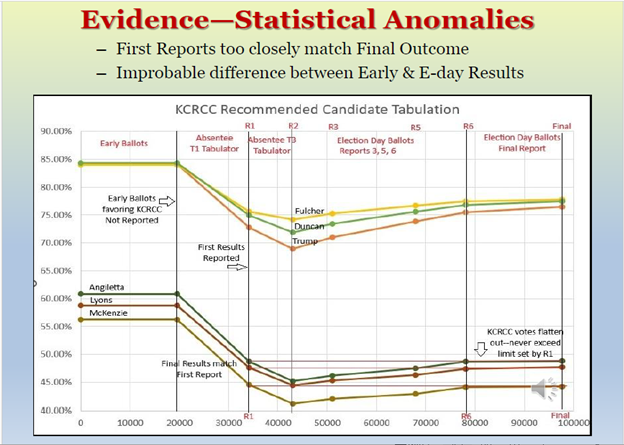
There are two issues here. The first issue is much more important than the other. For Eye on Elections claims of voter fraud to be true, then Early voting must consistently be a predictor for Election Day voting.
- It appears Eye on Elections assumes Early voting is a predictor for Election Day voting.
- Eye on Elections combines results from local, state and national elections to come to this conclusion.
Early Voting does not predict Election Day Voting
In order to review whether this claim can be supported, we looked at only local races in Kootenai County from May of 2022 until May of 2025. Data collected from Kootenai County’s official Results by Precinct. https://www.kcgov.us/915/Past-Elections
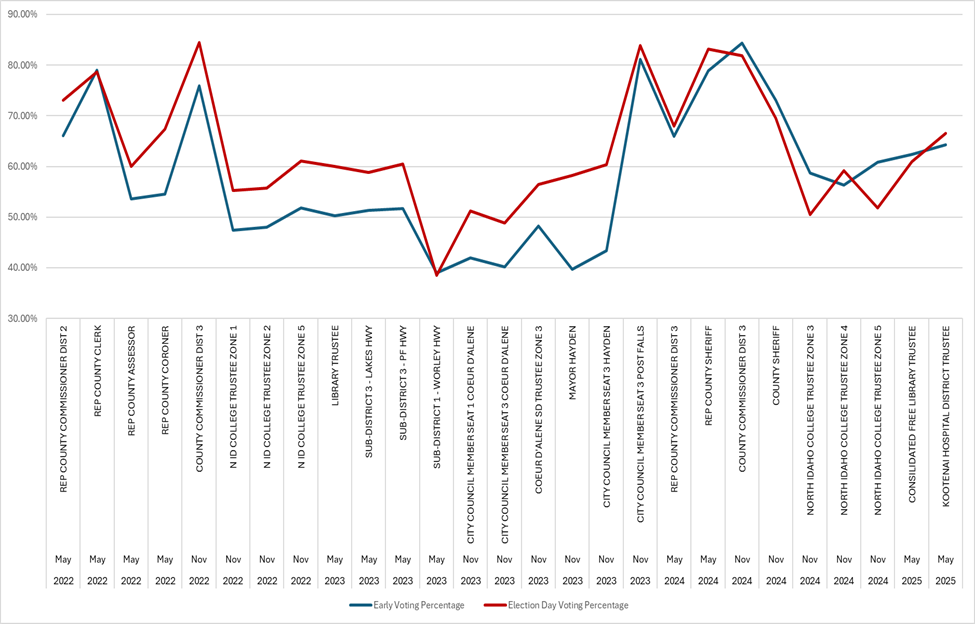
In November 2022, Day of election voting was an average of 8% to 10% higher than early voting. By May of 2024, the gap from 2022 had narrowed significantly. In November of 2024, election day voting was consistently lower than early voting. In May of 2025, early voting comparisons to election day voting were mixed.
If Early voting correctly predicted election day voting, the lines in the graph would consistently mirror one another. They don’t. Without this assumption being true, Eye on Elections claims cannot be substantiated.
KCRCC Candidates Receive Different Levels of Participation
The other component to all the data we compared was the level of voter participation. Because 2024 was a presidential election, voter turnout was high. However, the level of participation decreases when we look at local elections. When a voter fails to vote on a particular race, elections officials consider this an undervote. We compared the percentage of voters by precinct for the NIC races and the sheriff’s race for both 2024 and 2020. Notice that there is a significant drop off in voter participation between the sheriff’s race and the NIC race. The drop off is close to 20%. It is actually larger in 2020 than in 2024. What this means is that about 20% more people voted in the Sheriff’s race than in the NIC races. Data collected from Kootenai County’s official Results by Precinct. https://www.kcgov.us/915/Past-Elections
2024 Comparison
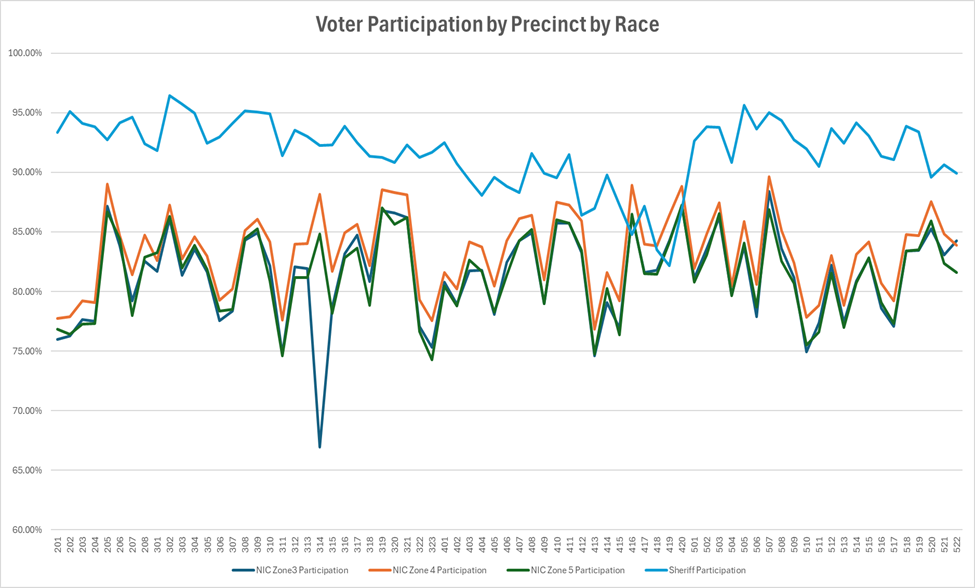
2020 Comparison
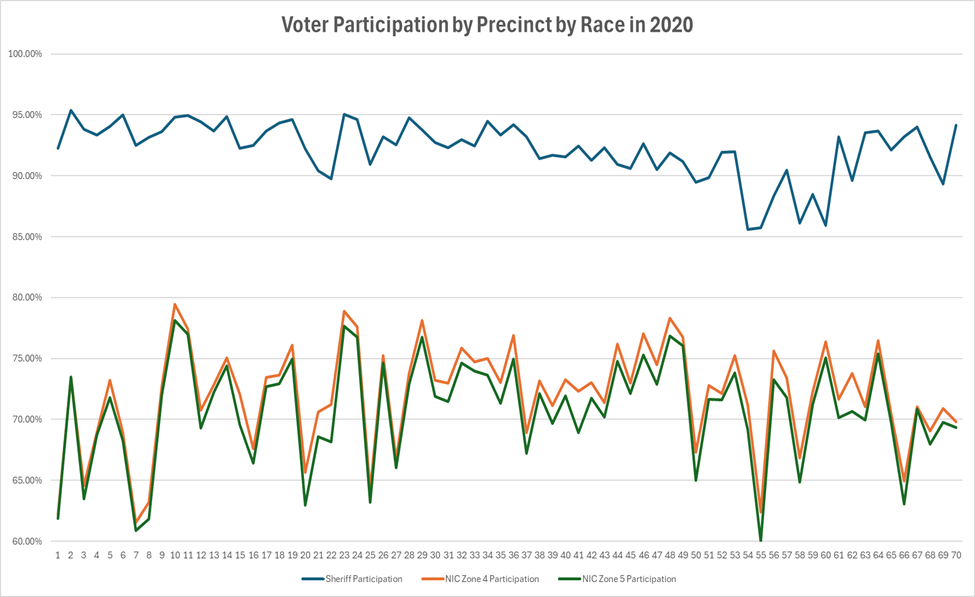
Voter Participation in Local Races has declined since 2020
Data analysis of voter participation in local races shows a slight decline since 2020. In order to come up with these numbers we had to look closely at the odd year elections which are all local and then find local races in the even year elections that had the highest level of participation. When this is all graphed out, the trend line becomes clear. It is important to note that when we compared elections from 2016 to 2025, we see voter participation in local elections increasing. Data collected from Kootenai County’s official results. https://www.kcgov.us/915/Past-Elections
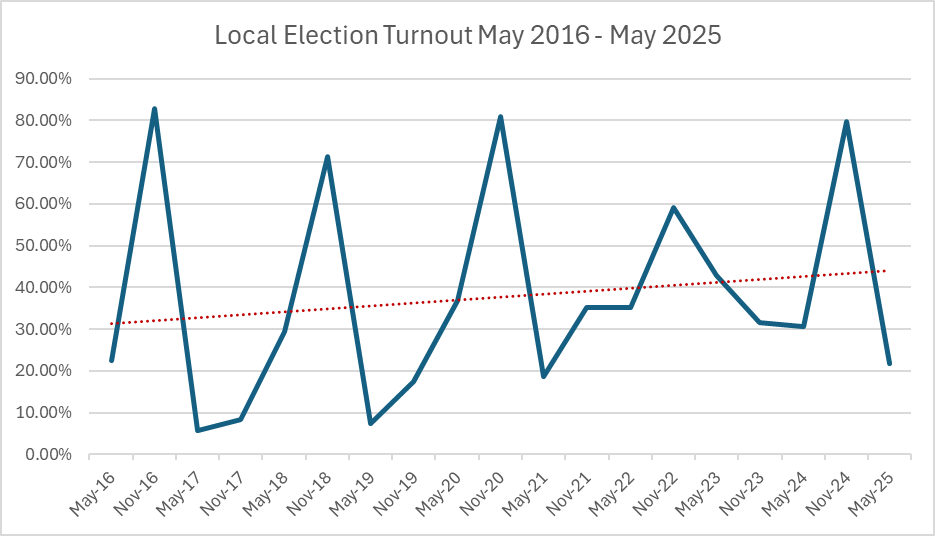
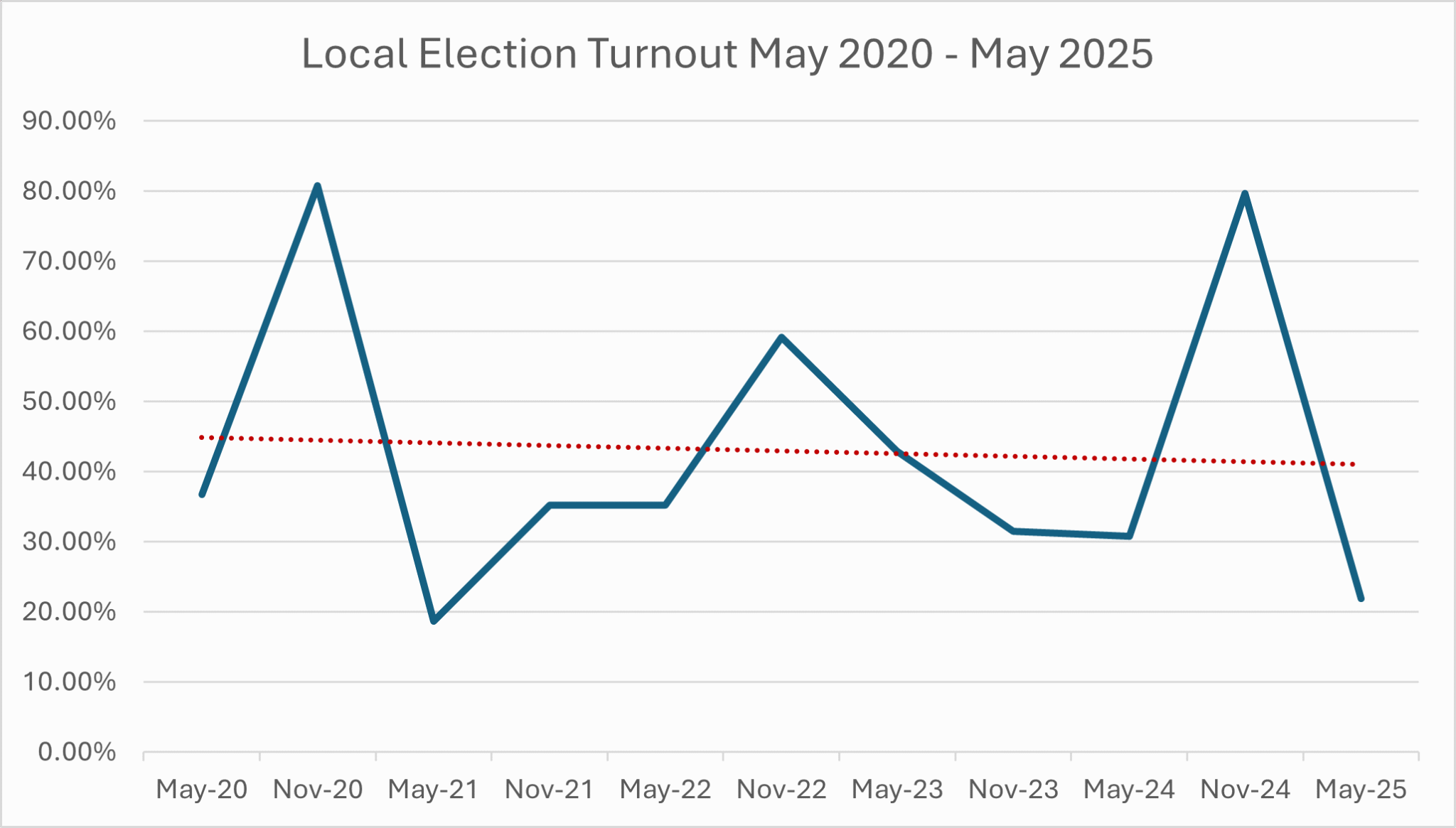
As local election turnout declines, it becomes easier for non-KCRCC candidates to win elections.
Further Research Into the Security of Kootenai County’s Elections
In an effort to get a better understanding of the security of Kootenai County Elections, we met with Jennifer Locke, Kootenai County Clerk. We wanted to see firsthand the security measures that are currently implemented. She was kind enough to review with us what Kootenai County does to ensure that all of the votes are counted accurately.
- There are multiple tests run on each vote counting machine. There is one public test per machine, but many internal test runs are done. All of the test runs, both public and private, are done with the same goal, to ensure that the voting machines are counting all of the different ballot styles correctly.
- There are multiple checks that are done as a part of election verification. For example, the number of absentee and early ballots are counted/tallied and verified against the number of ballots the machines count/tally. In addition, all of the precinct ballot totals are counted as well and compared to the number of ballots that the machines count.
- According to Idaho Law 34-2410, number 3: “No vote tally system (machine) shall be connected to the internet at any time, and no vote tally system shall receive or transmit data through wireless communications.”
- Kootenai County is the largest central counting county in the state of Idaho. Both Ada County and Canyon County have multiple locations that count votes.
- In order to upload counts to the state, one of the counting machines has to stop counting. The data is then copied to a clean memory stick which is taken to a separate computer to upload the data to the state. This is the reason why Kootenai County does not provide frequent updates on vote tallies.
Idaho’s Secretary of State does election audits for random counties. Kootenai County elections have been audited twice, both times in 2022. In both instances, the hand counts matched the machine counts exactly. Is there room for improvement? Certainly. There are opportunities to increase transparency through ballot images as well as audit logging of systems that would identify every single person who used any of the machines and what commands they ran.
In addition, Kootenai County is currently looking at upgrading their elections systems to improve transparency and speed of counting.
Can we hand-count all of the ballots?
Eye on Elections has suggested hand-counting every ballot, but this is an impractical solution at scale. To put it bluntly, what works at 1000 ballots, fails at 10,000 ballots and falls apart at 100,000 ballots. An Arizona county ran a small-scale test of 850 ballots and were unable to accurately tally the results with many different counting errors. Eye on Elections did run a successful test of over 600 ballots, but again this is a methodology that does not scale. There are 74 precincts in Kootenai County, several of which saw more than 1,800 ballots cast in November of 2024. Keep in mind that Eye on Elections did this with eight people. For their method to work at scale, we would need nearly 600 people just to do the hand counts at each precinct. Currently Kootenai County has trouble getting 500 volunteers to run the election.
In Conclusion
The Bottom Line: In our opinion, Eye on Elections claims cannot withstand a legal challenge.
Our intent was to host the event and have Teressa Roth from Eye on Elections as a guest speaker. She decided to advertise the event in a way that created public perception that both Watchmen Ministry North Idaho and Eye on Elections were presenting her information. This places us in the position of having to be able to support her claims. We did not see Eye on Elections slides and data until Monday June 9th. We reviewed their data on Tuesday. Based on our findings, we cancelled the event on Wednesday. The data we found does not support her claims; therefore, in our opinion her claims cannot withstand a legal challenge.
It would be irresponsible for us to present Eye on Elections claims to which we do not agree.
